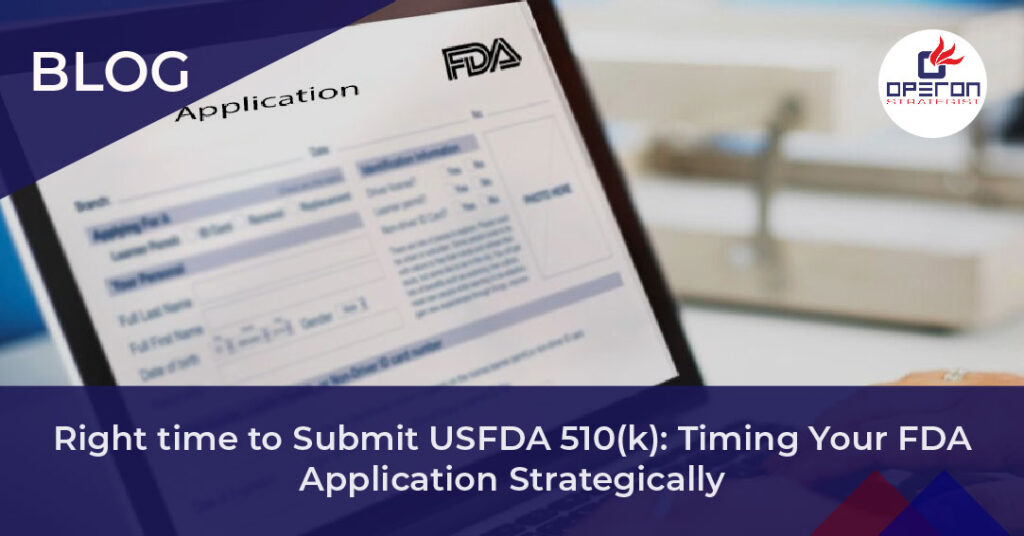Understanding the USFDA 510(k) Submission: A Critical Step for Medical Device Approval
The USFDA 510(k) submission is a crucial regulatory requirement for medical device manufacturers seeking to enter the U.S. market. This process ensures that your device is safe, effective, and substantially equivalent to an existing legally marketed device. Properly timed and accurately filed submissions can lead to market success, competitive advantage, and enhanced patient safety, while also promoting innovation and regulatory compliance.
Also read our service page: US FDA 510(k) consultant for medical devices and IVDs
Looking For a Medical Device Regulatory Consultant?
Let’s have a word about your next project
Importance of Timely and Accurate USFDA 510(k) Submission: -
Market Advantage: Submitting your USFDA 510(k) early allows you to capitalize on market opportunities, giving your medical device a competitive edge.
Efficient Review: Early submissions provide the FDA with sufficient time for a thorough review, reducing the risk of rushed assessments or overlooked details.
Swift Approval: Properly timed submissions result in faster approvals, accelerating your device’s entry into the market.
No Delays: Accurate and complete submissions prevent delays due to rejections or requests for additional information, ensuring a smooth approval process’s
Clear Documentation: Providing clear and precise data minimizes back-and-forth communication with the FDA, streamlining the review process.
Risk Mitigation: Accurate filings reduce the likelihood of safety concerns or misunderstandings during the review process.
Competitive Edge: Achieving timely and accurate approval helps you stay ahead of competitors and secure a larger share of the market.
What is USFDA 510(k) Application?
The USFDA 510(k) submission is a premarket requirement for many medical devices in the U.S. It is used to demonstrate that your device is substantially equivalent to a legally marketed device (predicate) in terms of safety and effectiveness. While primarily applicable to moderate-risk Class II devices, some Class I and Class III devices may also require a 510(k) submission.
Key Differences Between USFDA 510(k) and Premarket Approval (PMA) Processes
USFDA 510(k) | Premarket Approval (PMA) |
Purpose: Demonstrates new device similarity to an existing one | Purpose: Assesses high-risk Class III devices’ safety and effectiveness |
Requirement: Needed for moderate-risk Class II devices | Requirement: Mandatory for high-risk or novel devices without a predicate |
Evidence: Relies on comparison to a predicate, often without clinical trials | Evidence: Requires extensive clinical data from studies |
Choosing the Right Path:
- USFDA 510(k): Best for devices with similar counterparts and lower/medium risk.
- PMA: Required for novel devices or those with higher risks.
When is a USFDA 510(k) Typically Required?
- Introducing a device to the U.S. market for the first time.
- Changing the indications for use of a previously cleared device.
- Making significant modifications to a previously cleared device.
Medical Device Classification and 510(k) Submissions
Class | Risk Level | Regulatory Control |
Class I | Minimal | General Controls |
Class II | Medium | General and Special Controls (USFDA 510(k)) |
Class III | High | General Controls and Premarket Approval |
Medical device classification largely determines whether a USFDA 510(k) submission is necessary. Generally, moderate-risk devices (Class II) require 510(k) submissions to prove substantial equivalence to an existing predicate device. The FDA mandates that the 510(k) submission be filed at least 90 days before marketing, allowing ample time for review.
Identifying Predicate Devices: Key Considerations
A predicate device is an already approved device that your new device will be compared to, demonstrating its safety and effectiveness. This comparison is known as “substantial equivalence.” The new device doesn’t need to be identical but must match in terms of intended use and technology.
How to Identify a Predicate Device:
- Intended Use: Ensure your device’s purpose aligns with that of the predicate.
- Technological Match: The design, materials, and operation should be similar.
- Current Tech: Choose a predicate that represents up-to-date technology.
When to Submit a New 510(k):
- Significant modifications impacting safety, effectiveness, or intended use.
- New device introductions or major updates requiring new performance data.
When to Use a Letter to File (LTF):
Minor changes that do not affect the device’s core functionality, safety, or intended use.
USFDA's Review and Decision Process: A Quick Overview
- Day 1: USFDA receives the 510(k) application.
- Day 7: USFDA sends an Acknowledgment Letter or Hold Letter if there are issues.
- Day 15: USFDA completes Acceptance Review, deciding if the 510(k) is accepted or placed on RTA Hold.
- Day 60: Substantive Review, with possible requests for additional information.
- Day 90: Final MDUFA Decision on 510(k) submission.
- Day 100: If a decision is not reached, FDA provides a communication outlining outstanding issues.
Need Help Determining the Right Time to Submit Your USFDA 510(k)?
Expert Assistance in USFDA 510(k) Compliance
Navigating the USFDA 510(k) submission process requires precision and expertise. Operon Strategist is here to guide you through every step:
- Identifying the right predicate device.
- Determining testing requirements.
- Evaluating substantial equivalence.
- Preparing the 510(k) technical documents.
- Responding to FDA queries.
Our specialized QMS team also supports manufacturers in complying with US FDA 21 CFR 820.30 Design Control Requirements.
Need Expert Guidance on USFDA 510(k)?
- adminhttps://operonstrategist.com/author/admin-2/
- adminhttps://operonstrategist.com/author/admin-2/
- adminhttps://operonstrategist.com/author/admin-2/
- adminhttps://operonstrategist.com/author/admin-2/




